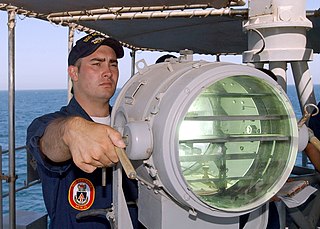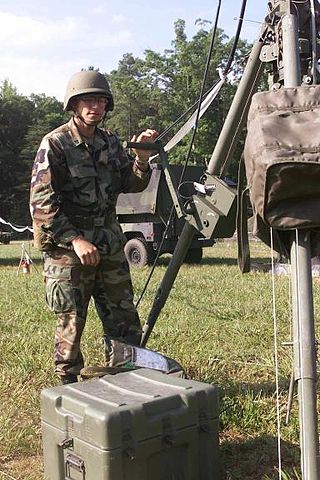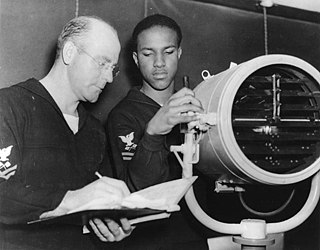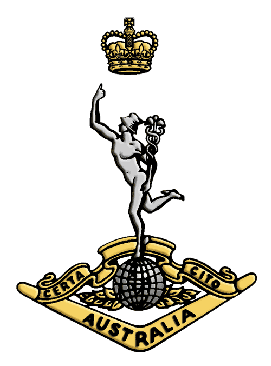
Signalman was a U.S. Navy rating for sailors that specialized in visual communication. See Signaller for more about the roles of Signalmen.

Signalman was a U.S. Navy rating for sailors that specialized in visual communication. See Signaller for more about the roles of Signalmen.

A signal lamp (also called an Signal Searchlight) is a visual signaling device for optical communication
In the U.S. Navy, "signalman" (nicknamed "Sigs", "Flags", or "Skivvy Waver") was a job field combining both visual communications, and advanced lookout skills. While there was certainly a Signalman rating before World War II (the Signalman rating is one of the oldest in the Navy), a specialized Signalman rating was established shortly after the war. Then, Signalmen were identified by the symbol of two crossed semaphore flags on the left sleeve of the uniform, integrated with their rank insignia. Signalmen were responsible for transmitting, receiving, encoding, decoding, and distributing messages obtained via the visual transmission systems of flag semaphore, visual Morse code, and flaghoist signalling.
The U.S. Navy disestablished the rating of Signalman in late 2003, reassigning visual communications duties to the Quartermaster rating. Signalmen were either absorbed into the Quartermaster rating, or allowed to switch to other job fields in the Navy. [1] Many chose the Master-at-Arms rating, which expanded dramatically to meet the needs of the Navy in the War on Terror.

Signalman was a trade category in use by the Royal Australian Navy until its amalgamation with the Radio Operator category in 1999. This new category, known as Communications and Information Systems, has retained traditional means of transmitting and receiving messages, such as flashing light and flags.
In the Australian Army, a Signalman (or "sigs") is an Other Rank (OR) that specialises in varied forms of communication. All signalmen are part of the Royal Australian Corps of Signals. Signalmen have a worn rank of Private.
In the British Army's Royal Corps of Signals, a private soldier's rank is a Signalman. Non-Royal Signals operators are referred to as Signallers; this is a qualification and not a rank.[ citation needed ]

Telegraphy is the long-distance transmission of messages where the sender uses symbolic codes, known to the recipient, rather than a physical exchange of an object bearing the message. Thus flag semaphore is a method of telegraphy, whereas pigeon post is not. Ancient signalling systems, although sometimes quite extensive and sophisticated as in China, were generally not capable of transmitting arbitrary text messages. Possible messages were fixed and predetermined and such systems are thus not true telegraphs.

An optical telegraph is a line of stations, typically towers, for the purpose of conveying textual information by means of visual signals. There are two main types of such systems; the semaphore telegraph which uses pivoted indicator arms and conveys information according to the direction the indicators point, and the shutter telegraph which uses panels that can be rotated to block or pass the light from the sky behind to convey information.

Optical communication, also known as optical telecommunication, is communication at a distance using light to carry information. It can be performed visually or by using electronic devices. The earliest basic forms of optical communication date back several millennia, while the earliest electrical device created to do so was the photophone, invented in 1880.

Quartermaster is a military term, the meaning of which depends on the country and service. In land armies, a quartermaster is generally a relatively senior soldier who supervises stores or barracks and distributes supplies and provisions. In many navies, a quartermaster is an officer with particular responsibility for steering and signals. The seaman is a non-commissioned officer rank; in some others, it is not a rank but a role related to navigation.
Flag signals can mean any of various methods of using flags or pennants to send signals. Flags may have individual significance as signals, or two or more flags may be manipulated so that their relative positions convey symbols. Flag signals allowed communication at a distance before the invention of radio and are still used especially in connection with ships.

A signaller, signalman, colloquially referred to as a radioman or signaleer in the armed forces is a specialist soldier, sailor or airman responsible for military communications. Signallers, a.k.a. Combat Signallers or signalmen or women, are commonly employed as radio or telephone operators, relaying messages for field commanders at the front line, through a chain of command which includes field headquarters. Messages are transmitted and received via a communications infrastructure comprising fixed and mobile installations.

The United States Army Signal Corps (USASC) is a branch of the United States Army that creates and manages communications and information systems for the command and control of combined arms forces. It was established in 1860, the brainchild of Major Albert J. Myer, and had an important role in the American Civil War. Over its history, it had the initial responsibility for portfolios and new technologies that were eventually transferred to other U.S. government entities. Such responsibilities included military intelligence, weather forecasting, and aviation.

Military communications or military signals involve all aspects of communications, or conveyance of information, by armed forces. Examples from Jane's Military Communications include text, audio, facsimile, tactical ground-based communications, naval signalling, terrestrial microwave, tropospheric scatter, satellite communications systems and equipment, surveillance and signal analysis, security, direction finding and jamming. The most urgent purposes are to communicate information to commanders and orders from them.

A signal lamp is a visual signaling device for optical communication by flashes of a lamp, typically using Morse code. The idea of flashing dots and dashes from a lantern was first put into practice by Captain Philip Howard Colomb, of the Royal Navy, in 1867. Colomb's design used limelight for illumination, and his original code was not the same as Morse code. During World War I, German signalers used optical Morse transmitters called Blinkgerät, with a range of up to 8 km (5 miles) at night, using red filters for undetected communications.

A signalman is a person who historically made signals using flags and light. In modern times, the role of signalmen has evolved and now usually uses electronic communication equipment. Signalmen usually work in rail transport networks, armed forces, or construction. Many armed forces now use the rank of signaller instead.

The Royal Australian Corps of Signals (RASigs) is one of the 'arms' of the Australian Army. It is responsible for installing, maintaining, and operating all types of telecommunications equipment and information systems. The motto of the Signals Corps is Certa Cito and is translated as 'Swift and Sure', signifying the aim of the signal service – that communication be carried out with maximum speed and certainty. Like their British counterparts, the Royal Australian Corps of Signals' flag and hat badge feature Mercury, the winged messenger of the gods, affectionately referred to by members of the corps as "Jimmy".

The Communications and Electronics Branch is a personnel branch of the Canadian Armed Forces (CAF). The army component of the branch is designated the Royal Canadian Corps of Signals.
ACP-131 is the controlling publication for the listing of Q codes and Z codes. It is published by the Combined Communications Electronics Board (CCEB) countries, and revised from time to time. When the meanings of the codes contained in ACP-131 are translated into various languages, the codes provide a means of communicating between ships of various nations, such as during a NATO exercise, when a common language is not in effect.

The Signal Corps in the American Civil War comprised two organizations: the U.S. Army Signal Corps, which began with the appointment of Major Albert J. Myer as its first signal officer just before the war and remains an entity to this day, and the Confederate States Army Signal Corps, a much smaller group of officers and men, using similar organizations and techniques as their Union opponents. Both accomplished tactical and strategic communications for the warring armies, including electromagnetic telegraphy and aerial telegraphy. Although both services had an implicit mission of battlefield observation, intelligence gathering, and artillery fire direction from their elevated signal stations, the Confederate Signal Corps also included an explicit espionage function.
A radiogram is a formal written message transmitted by radio. Also known as a radio telegram or radio telegraphic message, radiograms use a standardized message format, form and radiotelephone and/or radiotelegraph transmission procedures. These procedures typically provide a means of transmitting the content of the messages without including the names of the various headers and message sections, so as to minimize the time needed to transmit messages over limited and/or congested radio channels. Various formats have been used historically by maritime radio services, military organizations, and Amateur Radio organizations.

Flag semaphore is a semaphore system conveying information at a distance by means of visual signals with hand-held flags, rods, disks, paddles, or occasionally bare or gloved hands. Information is encoded by the position of the flags; it is read when the flag is in a fixed position. Semaphores were adopted and widely used in the maritime world in the 19th century. It is still used during underway replenishment at sea and is acceptable for emergency communication in daylight or using lighted wands instead of flags, at night.
Naval flag signalling covers various forms of flag signalling, such as semaphore or flaghoist, used by various navies; distinguished from maritime flag signalling by merchant or other non-naval vessels or flags used for identification.

Semaphore is the use of an apparatus to create a visual signal transmitted over distance. A semaphore can be performed with devices including: fire, lights, flags, sunlight, and moving arms. Semaphores can be used for telegraphy when arranged in visually connected networks, or for traffic signalling such as in railway systems, or traffic lights in cities.

Wigwag is an historical form of flag signaling that passes messages by waving a single flag. It differs from flag semaphore in that it uses one flag rather than two, and the symbols for each letter are represented by the motion of the flag rather than its position. The larger flag and its motion allow messages to be read over greater distances than semaphore. Messages could be sent at night using torches instead of flags.